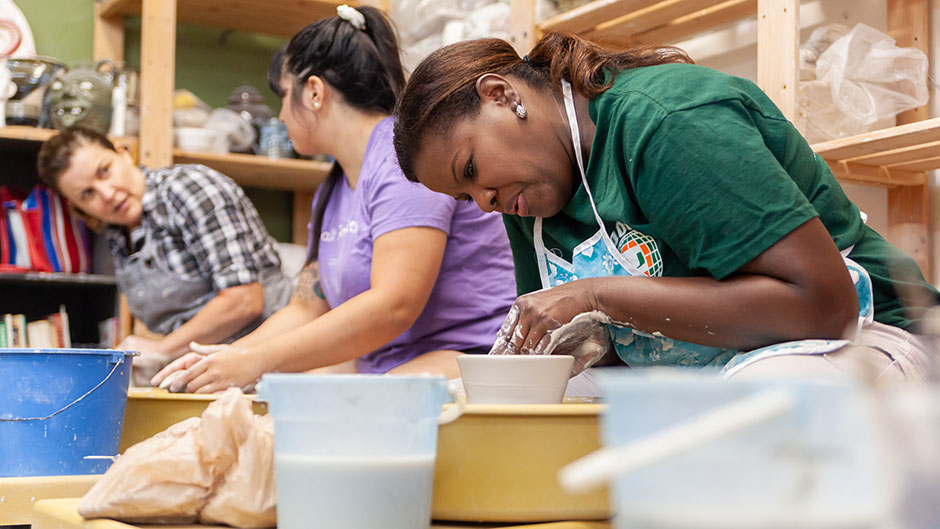Dr. Stefanie Brown sets the lump of moist clay on the wheelhead, then pumps the pedal to set the potter’s wheel spinning. After her busy work week, controlling the whirling wheel feels satisfying. With her fingers shaping the clay and her attention focused, Dr. Brown enjoys coaxing forth a new creation. Attending weekend sessions at the Anhinga Clay Studios in SW Miami and the chance to practice her favorite pastime are restorative and integral to her wellbeing.
“Working on the pottery wheel is meditative, and all the people in the class are so nice—I really love the community here,” she laughed. “It’s mostly for fun, because my pottery’s not that great. And working in the field of medicine, you really need to have a good life balance.”
Dr. Brown serves as the program director for the Internal Medicine Residency Program, UM-Jackson Memorial, and also holds a dual section chief role, both for Pediatric Hospital Medicine and for Med Peds, an abbreviation for Combined Internal Medicine and Pediatrics, which is the four-year residency leading to board certification for both specialties.
A former assistant dean for Diversity and Inclusion at the Miller School of Medicine, she was recently appointed to the executive committee of the Med-Peds Program Director Association as a diversity advisor. In late March she traveled to New Orleans for the national meeting to explore together with colleagues educational innovation and modes of assessment.
As program director of Med Peds, she’s responsible for all administrative functions for 126 residents, some “categorical”—those completing their three years of residency at UM—and others doing just one year. Supported by six associate program directors, she’s organizing a new educational clinical curriculum that will be aligned with the American Board of Internal Medicine of the Accreditation Council for Graduate Medical Education's (ACGME) vision for the physician of the future. The curriculum is geared toward the future business of medicine, population health, and social justice.
“Medicine is an ever-changing landscape, and part of my job is to know and understand that landscape—political, economic, what’s going on with Medicaid and Social Security—and to communicate it to the residents,” Dr. Brown said. “It’s exciting and fun, and I realized that to get better at my job I needed more business savvy, so I started my MBA here in January to help me develop better leadership strategy.”
Born and raised in New Jersey, Dr. Brown has the bloodlines of an educator—her mother was a teacher, her father a principal. She earned her degree at the University of Cincinnati College of Medicine, then returned to her home state for her residency and first seven years of faculty at Rutgers New Jersey Medical School.
While working there, she resided in New York City. The rigorous schedule and 40-minute daily commute led her to take up the pastime of pottery and also taught Brown that walking—a lot—was an exercise that added immeasurably to her sense of wellbeing.
Recruited for the Med-Ped's program director position at UHealth in 2008, she relocated to Miami and looked for a neighborhood that was relatively close to the medical campus and also one where she could walk safely and at will.
“Now there are a lot more neighborhoods where you can walk around, but then Miami Beach was the place. I really enjoy having my apartment there, so close to the water.”
What does she like best about her work at UHealth?
“Being able to mentor is one of the things that I really enjoy and, through developing curricula and programs, I want to be creative in my job,” she said. “One of the things that attracted me to come here was that everyone I interviewed with was doing something exciting—that this was really a place of support and innovation.
“When I come up with some new or novel idea, it’s always supported and someone is connecting me with someone else who can help. The diversity of interests is one of the beauties of working here.”
Dr. Brown dedicates 50-percent of her time to her program director responsibilities and 50-percent to her Med-Peds clinical roles and section chief roles with Med-Peds and Pediatric Hospital Medicine.
“I try to do five half-days a week of administrative work when on the in-patient service, which ends up leaving a lot of work for nights and weekends,” she said. "It’s like having three or four jobs at a time between program director and my section responsibilities which involve faculty mentorship and clinical operations development. That’s another reason that the MBA will be important."
Establishing a healthy work life balance doesn’t come easy for many medical professionals—though they are in the field of health. Schedules are grueling and demands are constant and high stake.
Dr. Brown recognizes that burnout is a big topic in the field. She mentioned a new movement that recognizes a sense of “moral injury” for professionals not taking care of themselves, dedicating themselves instead to caring for their patients. “That’s the part we all love,” she said.
She loves her work and appreciates her many leadership roles. “That’s what keeps me here working in an environment where innovation and forward thinking are rewarded. It’s inspiring.”
Yet given the many workplace demands, even that inspiration needs an occasional recharge. For Dr. Brown, that comes with weekend mornings at Anhinga Clay Studios—seated at the spinning potter’s wheel, fingers deep in the cool moist clay.

